 Sunday/Weekend
Sunday/Weekend

This year commemorates the 80th anniversary of the Outline on Việt Nam's Culture, penned by Party General Secretary Trường Chinh, which directed the country's artists and communities to flourish. Nguyễn Bình* looks further into the role artists play.
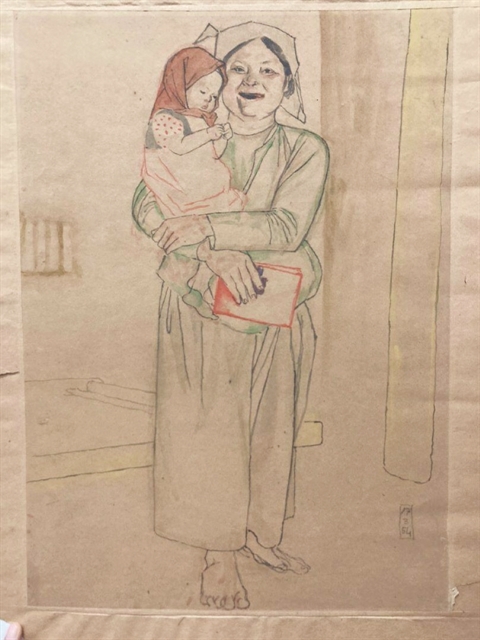 |
A recent exhibition at the Việt Nam National Museum of Fine Arts offers a rare chance for fine arts lovers to look back at masterpieces by some of the country's greatest 20th century painters, and learn about the artistic response to the “Outline of Vietnamese Culture” written by the then General Secretary Trường Chinh of the Communist Party of Việt Nam 80 years ago.
"Culture is among three cornerstones with politics and economy for the nation's development," said Prime Minister Phạm Minh Chính at a ceremony held to mark the historic document on February 28 at Hà Nội Opera House.
"If culture remains, the country remains; otherwise, there will be no more Vietnamese people. Culture is the spiritual foundation of society," the Prime Minister said.
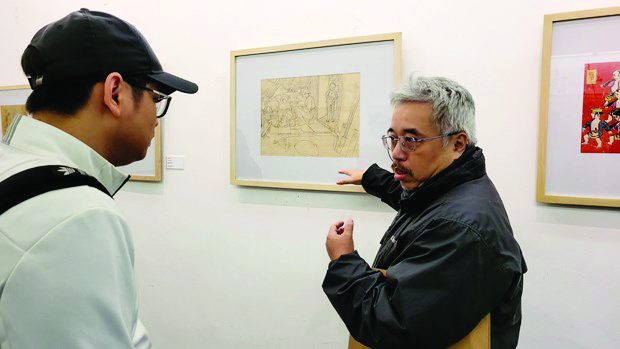 |
He also stressed the need to continue researching and clarifying the direction and viewpoint for Việt Nam's culture, adding more to developing the Outline.
The exhibition is among a series of cultural activities held throughout the country. It displays 80 paintings made in 1945-54, when Việt Nam was fighting against the French invasion. The artworks were created by 30 artists, including 22 graduates from the Indochina School of Fine Arts.
The school, now the Việt Nam Fine Arts University, was the first of its kind in the country established by French painter Victor Tardieu and Vietnamese painter Nam Sơn.
“The Outline of Vietnamese Culture in 1943 is an important historical document in the cause of national liberation,” said the museum director Nguyễn Anh Minh.
“It shows the path of movement and development of the new Vietnamese culture. The Outline defined three principles in this new culture – 'nationalisation, popularisation, and scientification' – which attracted a great number of Vietnamese intellectuals, writers and artists.
“The exhibits reflect the transformation of the ideological consciousness of the artists. They left behind lives of urban prosperity to participate in the cause of national liberation, bravely taking responsibility to build and develop a new Vietnamese culture.”
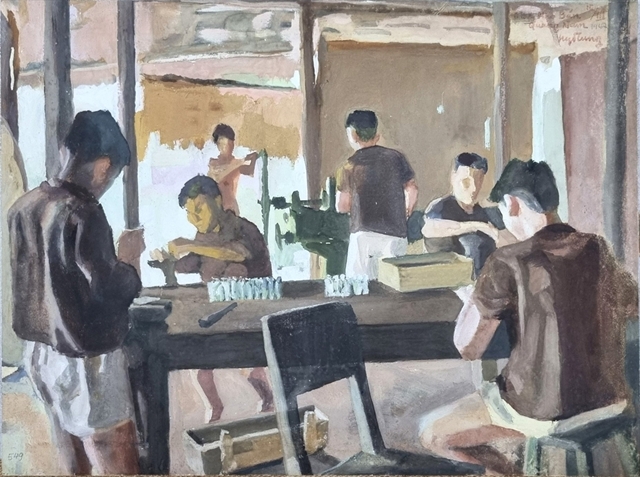 |
“It's our first day looking here. There are many ethnic works,” said Maria Johnson, 60, an Australian tourist.
She noted the important role of labour reflected in the paintings: “A lot of the artworks are about people working. I often go to other places in Europe, the paintings are mainly about landscapes or people of religion.”
In a letter addressing the country's National Conference on Culture in 1948, then President Hồ Chí Minh wrote, "In our great common endeavour to resist against oppression and rebuild our country, culture plays a vital role. We need to build up our common culture that touches upon our people from all walks of life. The duty of culture and those who work in it is not only to encourage all forces to fight for national freedom, and rebuild our country, but also to showcase our great achievements for the world to see. Culture (our artists and musicians, writers and actors) needs to create great works that reflect not only our ongoing career to fight oppressors and rebuild our country, but also for generations to come to know the common efforts of all the people."
Artist-cum-freedom fighter
Artists-soldiers recorded images of the war of resistance, labour and production over the years.
Their works include Du Kích La Hai (La Hai Guerrillas) by Nguyễn Đỗ Cung, Bác Hồ Làm Việc Tại Bắc Bộ Phủ (President Hồ Chí Minh Works at Tonkin Palace) by Tô Ngọc Vân, Dao Găm Rèn Cho Du Kích (Forging Daggers for Guerrillas) by Nguyễn Hiêm.
“The artists took part in the national war of resistance (against the French) in 1945 showing their willingness to serve the national cause,” said Lương Xuân Đoàn, chairman of the Việt Nam Fine Arts Association.
“It was time for the artists to express their patriotism quickly through their direct sketches to record the new beauty of the people against the adversities of wartime.
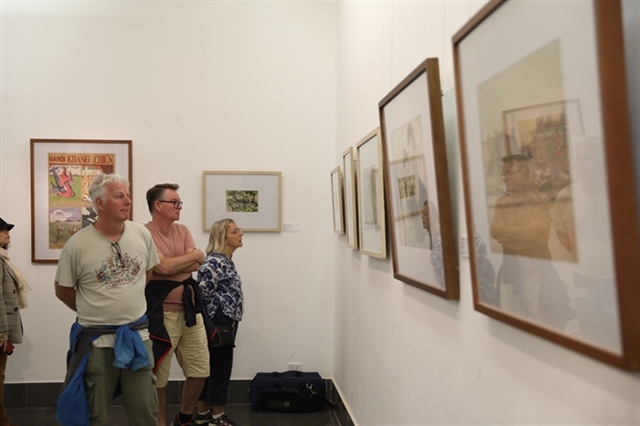 |
“We have seen the path for Vietnamese literature and arts development set by the Communist Party of Việt Nam in 1943. It has been a guideline for developing Vietnamese culture and art over the past 80 years.”
The paintings were among the last ones completed by Vân. They are ink sketches and water-colours made by the artist in 1954, who died that year because of French air bombardment during the Điện Biên Phủ battle.
Vân graduated from the Indochina School of Fine Arts in 1931. At the beginning of his career, he was inspired by young women. He would draw the gentle beauty of Vietnamese urban women. His most popular paintings at that time were Thiếu Nữ Bên Hoa Huệ (Young Woman with Lillies) and Hai Thiếu Nữ và Em Bé (Two Girls and a Baby).
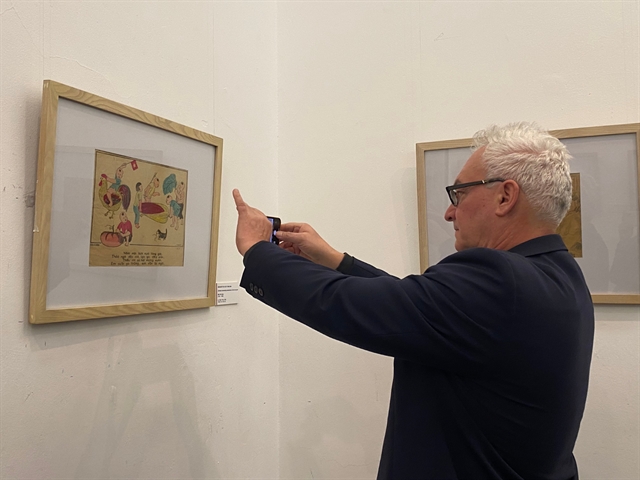 |
Following the Outline and the August Revolution in 1945, Vân had changed his creativity to meet new demands of the resistance war. He used his brush to depict soldiers and people serving the resistance. His works portray strong women in the smoke and fire of war, or soldiers on the battlefield.
His paintings help people clearly see the situation of the country, and strength in the struggle for independence.
Each of his paintings is not only a work of art, but it is also a weapon of struggle, as well as encouragement and praise for the populace's fighting spirit.
Vân's grandchild Tô Ngọc Thảo is among the exhibition viewers, and moved to see his grandfather’s paintings, including Bủ Đường Biết Đọc (Bủ Đường Can Read), Hoan Hô (Applause), and May Áo (Sewing), among others.
“It is emotional to see paintings by artists in a time of national resistance,” Thảo said.
“May Áo was painted by my grandfather one day before he died. I was born after his death, so I am very moved to see the painting. It features ethnic minority people’s spirit to support the national resistance through simple and small work.”
Artist Nguyễn Đỗ Cung graduated from the school in 1934. He was one of the urban artists to be refreshed and get energy after the success of the August Revolution in 1945.
Cung taught painting at private schools in Hà Nội, and he ran a lacquer painting workshop after his graduation.
His 17 works are in the national museum’s collection. His career can be seen in different periods. Before 1945, he focused on ancient architecture and experimented with cubism.
He went to Japan in 1940 to research Japanese lacquer art. His popular paintings at that time were about landscape and the literary character Từ Hải from the Vietnamese masterpiece Tale of Kiều.
Cung was active in painting and teaching in 1945-54. Gouache-painting Du Kích La Hai (La Hai Guerrillas) was made by Cung when he went to the battlefield in the South in 1947. Cung drew the painting at the first stop in Tuy Hòa in the central province of Phú Yên.
 |
The exhibition also displays another gouache-painting entitled Làm Kíp Lựu Đạn (Making Grenade Detonators) in 1947. The painting features four soldiers installing a grenade launcher on a big table and two others working on a machine. The light outside the shack contrasts and highlights the soldiers working hard.
Cung was recognised as a pioneer soldier on the cultural front. He was posthumously given the Hồ Chí Minh Award in 1996.
“He was successful depicting the spirit of the soldiers and the people at the beginning of the national war of resistance in his paintings,” the award council said.
Association chairman Đoàn said: “These war of resistance artists were at a young golden age when they saw the Outline of Vietnamese Culture. It helped the artists find themselves and showed them the path to serve the national cause."
“Eighty years have passed, but the three principles outlined in the document still remain pillars in promoting the development of Việt Nam’s culture today. The transformation in ideological consciousness and actions of previous generations of artists have strongly influenced today’s artists.”
The exhibition honours and pays tribute to generations of artists who have devoted their enthusiasm and even their life to the motherland and the people, contributing to the enrichment of Vietnamese culture.
Alan Johnson, 60, an Australian tourist, told Việt Nam News, "We have looked on the internet for the greatest Vietnamese artworks, and we’ve seen here."
“We have been to a lot of art galleries in the world, but this is the first time we’ve been to a communist art gallery. It’s better than I expected.”
From all parts of Việt Nam, artists became soldiers on the cultural front, taking the task of serving the homeland and people’s happiness as sources of inspiration and creativity. VNS
*Additional reporting by Tường Vân




